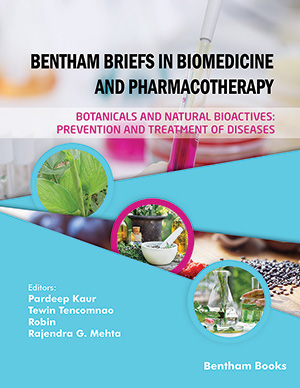Abstract
Orthosiphon aristatus has been known for its medicinal uses. One of the compounds responsible for the pharmacological activities of O. aristatus is a flavonoid called Eupatorin (EUP). EUP has been studied for its pharmacological activities, including anti-inflammatory, vasodilating, antiproliferative, hepatoprotective, analgesic, and antidiabetic properties. Despite its importance and abundance, currently, there is no published paper that reviews the characteristics, pharmacological activities and isolation methods of EUP. This review summarizes the botanical origin, phytochemical characteristics, pharmacological activities, isolation, as well as identification and characterization methods of EUP from O. aristatus. This paper also compares different isolation methods based on the parameters and the resulting yields. Various isolation methods had been used to obtain EUP. Reverse-phase high-performance liquid chromatography (HPLC) is the most commonly used method to isolate EUP, followed by preparative thin layer chromatography (TLC) and crystallization for the purification. Various spectroscopic methods, including UV-Vis, FT-IR, Mass, and NMR spectroscopy have been commonly used to identify and characterize EUP. This paper provides a comprehensive insight into EUP from O. aristatus which might be beneficial for future research using this compound.
Keywords: Orthosiphon aristatus, eupatorin, pharmacology, isolation, anti-inflammatory, botanical source.
[http://dx.doi.org/10.3389/fphar.2020.00692] [PMID: 32477146]
[http://dx.doi.org/10.3923/ijb.2006.1.6]
[http://dx.doi.org/10.4103/JPBS.JPBS_253_17] [PMID: 30237681]
[http://dx.doi.org/10.1089/jmf.2006.065] [PMID: 18598181]
[http://dx.doi.org/10.37287/jppp.v2i3.140]
[http://dx.doi.org/10.1016/j.ejphar.2016.06.047] [PMID: 27370961]
[http://dx.doi.org/10.1016/j.fitote.2012.06.002] [PMID: 22698713]
[http://dx.doi.org/10.1038/s41598-018-37796-w] [PMID: 30728391]
[http://dx.doi.org/10.1155/2011/103039] [PMID: 21647311]
[http://dx.doi.org/10.3390/molecules15064452] [PMID: 20657453]
[http://dx.doi.org/10.3389/fphar.2020.553404] [PMID: 33628166]
[http://dx.doi.org/10.3390/molecules27103292] [PMID: 35630768]
[http://dx.doi.org/10.1177/1534735420935625] [PMID: 32830560]
[http://dx.doi.org/10.3390/molecules24142658] [PMID: 31340434]
[http://dx.doi.org/10.1002/fsn3.584] [PMID: 29876108]
[http://dx.doi.org/10.1016/j.phymed.2017.12.015] [PMID: 29433683]
[http://dx.doi.org/10.1021/jf404570s] [PMID: 24422962]
[http://dx.doi.org/10.3906/biy-1803-72] [PMID: 30814897]
[http://dx.doi.org/10.3390/molecules27020444] [PMID: 35056765]
[PMID: 26281557]
[PMID: 25276207]
[http://dx.doi.org/10.3390/plants10112245] [PMID: 34834609]
[http://dx.doi.org/10.1080/14786419.2016.1185718] [PMID: 27187805]
[http://dx.doi.org/10.1080/14786419.2021.1887175] [PMID: 33586545]
[http://dx.doi.org/10.1002/ptr.3187] [PMID: 21031625]
[http://dx.doi.org/10.1007/s10600-007-0232-9]
[http://dx.doi.org/10.1016/j.fitote.2012.04.006] [PMID: 22537643]
[http://dx.doi.org/10.1080/13880209.2016.1255980] [PMID: 27938087]
[PMID: 27991400]
[http://dx.doi.org/10.3390/ijms21144897] [PMID: 32664524]
[http://dx.doi.org/10.1021/acs.jafc.5b02842] [PMID: 26322527]
[http://dx.doi.org/10.1016/0031-9422(94)00840-P]
[http://dx.doi.org/10.1002/jps.2600660441] [PMID: 856983]
[http://dx.doi.org/10.1002/jps.2600540632] [PMID: 5847037]
[http://dx.doi.org/10.3390/metabo11080523] [PMID: 34436464]
[http://dx.doi.org/10.1248/bpb.25.875] [PMID: 12132661]
[http://dx.doi.org/10.1021/jf990444i] [PMID: 10552853]
[http://dx.doi.org/10.1248/cpb.53.1175] [PMID: 16141591]
[http://dx.doi.org/10.1155/2017/6746071] [PMID: 28115974]
[http://dx.doi.org/10.1055/s-0028-1097564] [PMID: 905420]
[http://dx.doi.org/10.3390/foods11121699] [PMID: 35741897]
[http://dx.doi.org/10.1016/j.bse.2010.01.014]
[http://dx.doi.org/10.1080/13880209.2017.1305423] [PMID: 28347190]
[http://dx.doi.org/10.1021/acs.jnatprod.6b00605] [PMID: 27679866]
[http://dx.doi.org/10.1016/j.fitote.2014.08.009] [PMID: 25128428]
[http://dx.doi.org/10.3390/plants11131739] [PMID: 35807691]
[http://dx.doi.org/10.3389/fphar.2017.00467] [PMID: 28790914]
[http://dx.doi.org/10.1080/14786411003766912] [PMID: 21108116]
[PMID: 24250350]
[http://dx.doi.org/10.1021/np970378j] [PMID: 9514012]
[http://dx.doi.org/10.1016/j.phytochem.2020.112653] [PMID: 33524860]
[http://dx.doi.org/10.1021/np1002516] [PMID: 20735065]
[http://dx.doi.org/10.1016/j.jpba.2020.113745] [PMID: 33190082]
[http://dx.doi.org/10.1021/acs.jnatprod.9b01024] [PMID: 32182064]
[http://dx.doi.org/10.1021/np50057a027] [PMID: 21401173]
[http://dx.doi.org/10.1021/np50038a037]
[http://dx.doi.org/10.3109/13880209.2016.1150304] [PMID: 26983579]
[http://dx.doi.org/10.1111/j.2042-7158.1998.tb06924.x] [PMID: 9811170]
[http://dx.doi.org/10.1080/10575639608044893]
[http://dx.doi.org/10.1055/s-2007-969198] [PMID: 17345353]
[http://dx.doi.org/10.1016/j.jff.2015.11.008]
[http://dx.doi.org/10.1016/j.bse.2007.04.013]
[http://dx.doi.org/10.3390/ijms160921109] [PMID: 26404257]
[http://dx.doi.org/10.1002/ptr.2021] [PMID: 17262892]
[http://dx.doi.org/10.1016/j.foodchem.2010.03.110]
[http://dx.doi.org/10.3390/molecules24173057] [PMID: 31443519]
[http://dx.doi.org/10.1039/D0RA03350B] [PMID: 35518153]
[http://dx.doi.org/10.22159/ijpps.2017v9i1.12407]
[http://dx.doi.org/10.3389/fchem.2020.507887] [PMID: 33102442]
[http://dx.doi.org/10.1086/321855] [PMID: 11524725]
[http://dx.doi.org/10.1016/j.biotechadv.2016.02.012] [PMID: 26946281]
[http://dx.doi.org/10.1016/j.enzmictec.2016.02.003] [PMID: 26992799]
[http://dx.doi.org/10.1016/j.foodchem.2004.01.008]
[http://dx.doi.org/10.1063/1.4966751]
[http://dx.doi.org/10.1016/j.tifs.2013.07.001]
[http://dx.doi.org/10.1016/j.arabjc.2011.06.016]
[http://dx.doi.org/10.1515/gps-2017-0027]
[http://dx.doi.org/10.1515/ijfe-2016-0094]
[http://dx.doi.org/10.3390/molecules24224183] [PMID: 31752230]
[http://dx.doi.org/10.22146/ijc.21661]
[http://dx.doi.org/10.1055/s-0028-1088379] [PMID: 19137497]
[http://dx.doi.org/10.4103/0974-8490.147195] [PMID: 25598631]
[http://dx.doi.org/10.4103/0974-8490.188872] [PMID: 27695261]
[http://dx.doi.org/10.1002/pca.1109] [PMID: 19140110]
[http://dx.doi.org/10.1016/S0021-9673(99)00726-8] [PMID: 10519098]
[http://dx.doi.org/10.5530/pj.2018.5.173]
[http://dx.doi.org/10.1007/s11164-018-3530-x]
[http://dx.doi.org/10.1055/s-0031-1298458] [PMID: 22516932]
[http://dx.doi.org/10.3109/03009734.2015.1064501] [PMID: 26220421]
[http://dx.doi.org/10.1186/1471-2121-14-32] [PMID: 23834359]
[http://dx.doi.org/10.3390/ijms21041388] [PMID: 32085654]
[http://dx.doi.org/10.1007/s13765-016-0160-0]
[PMID: 29373904]
[http://dx.doi.org/10.1038/cr.2010.149] [PMID: 21060336]
[http://dx.doi.org/10.1186/bcr2090] [PMID: 18454852]
[http://dx.doi.org/10.1155/2018/7253510] [PMID: 29785357]
[http://dx.doi.org/10.1016/j.yexcr.2011.12.014] [PMID: 22227008]
[http://dx.doi.org/10.3390/molecules27041149] [PMID: 35208939]
[http://dx.doi.org/10.1248/bpb.29.1039] [PMID: 16651742]
[http://dx.doi.org/10.1016/S0002-9149(02)02963-6] [PMID: 12459427]
[http://dx.doi.org/10.1016/0009-3084(87)90063-6] [PMID: 3319224]
[http://dx.doi.org/10.1016/j.jep.2005.01.018] [PMID: 15814258]
[http://dx.doi.org/10.1016/j.jams.2013.01.005] [PMID: 23433053]































